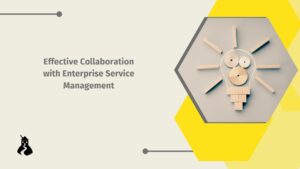
According to Forbes businesses worldwide have experienced a rapid digital transformation. Support teams have had to adapt to new communication methods for addressing service requests and support issues. As a result, some organisations have grappled with internal inefficiencies and communication barriers between departments. In this blog post, we’ll explore how to enhance collaboration amongst departments for streamlined service delivery and improved customer experience.
Identifying the Challenges
Before looking at solutions, organisations need to assess their current pain points. Are resources tied up in manual tasks? Do service agents find themselves overwhelmed by repetitive requests or interdepartmental inquiries? Are service requests getting lost in the shuffle? These are questions that demand attention if a business wants to enhance its service delivery without adding to its workload.
Moving from Cooperation to Effective Collaboration
Traditionally, organisations have focused on cooperation, expecting departments to work together to resolve service requests efficiently. However, in many cases, this approach falls short as employees struggle to navigate internal processes, leading to delays and frustration. Instead, fostering collaboration across departments can yield more effective outcomes.
The Role of Enterprise Service Management (ESM)
Enter Enterprise Service Management (ESM), a comprehensive approach to orchestrating an organisation’s service requests and notifications. ESM goes beyond mere cooperation by providing collaboration tools and workflows designed to promote collective intelligence and staff collaboration at the organisational level. Through shared portals, expert recommendations, and real-time collaboration, ESM streamlines communication and enhances productivity.
Key Components of Effective Collaboration
In our opinion three critical factors drive the effectiveness of collaboration through ESM:
- Communication
A robust ESM solution ensures that issues and requests are processed efficiently, nothing slips through the cracks. By centralising communications and setting up organisational standards, ESM ends confusion and ensures accountability.
- Content Management
By providing employees with self-help options through centralised portals and bots, ESM reduces reliance on traditional support channels, such as phone calls and emails, freeing up teams to focus on value-added tasks.
- Workflow
With flexible process and workflow design capabilities, ESM enables organisations to adapt to changing customer requirements swiftly. Automation and optimisation minimise manual effort and rework, allowing teams to deliver prompt solutions and tackle complex issues effectively.
Who Benefits from Effective Collaboration?
- Customers/End-Users – they will enjoy a seamless experience with a centralised platform for making requests, finding answers, and reporting issues.
- Executives & Decision Makers – Effective collaboration with the business helps gain greater transparency and insights into service delivery, enabling informed decision-making and value optimisation.
- Service Support Agents – By collaborating within a central solution, they can deliver consistent and reliable service while using self-service and automation tools to streamline workflows.
Fostering collaboration among departments is essential for organisations looking to enhance service delivery and customer satisfaction. By embracing Enterprise Service Management and prioritising effective communication, content management, and workflow optimisation, organisations can streamline operations, drive productivity, and deliver exceptional customer experiences.





